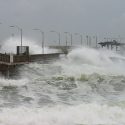New satellite tools putting hurricanes in sharper focus
A fleet of powerful new visualization tools is giving forecasters an unprecedented look into the anatomy of typhoons and hurricanes, helping refine early-warning systems.
 (View a larger version) A multi-channel satellite image composite of Hurricane Floyd.
|
|
Track current satellite data and storm track forecasts for: Visit CIMSS’ Tropical Cyclones page View a high bandwidth Java image loop created from super rapid scans of Hurricane Bret |
Beyond better resolution, these satellite-based tools are helping scientists break tropical cyclones down into their component parts, dissecting some of the forces that create, fuel and steer these dangerous storms.
"What we’re doing is fusing together images through the use of multiple satellites," says Chris Velden, a tropical cyclone researcher at UW–Madison. "Each satellite has its own view of the earth, and we’re piecing many of them together for a more complete picture."
This "data fusion" technique is the source of several new hurricane forecasting methods developed at UW–Madison that are in daily use at the National Hurricane Center in Miami and the Joint Typhoon Warning Center in Pearl Harbor.
The bank of images is publicly available on the web site of UW–Madison’s Cooperative Institute for Meteorological Satellite Studies (CIMSS) tropical cyclone team, a group led by Velden. Visitors can peruse recent and real-time movies and images of current tropical storms Floyd and Gert, or any current cyclone in the Atlantic or Pacific Ocean.
Velden says the new tools are designed to shed light on two of the biggest unknowns about tropical cyclones: Where they originate and how they gather and lose intensity. Just in the past five years, satellite technology has improved forecasting of the path of storms, but estimating their power has been difficult.
One new product introduced this year, called Wavetrak, combines data from five different satellites to create a 10-day movie loop of atmospheric waves sweeping out of central Africa, the birthplace of cyclones. Wavetrak is designed to study the atmospheric waves that act as a conveyor belt for conditions that cause cyclones.
"We’re grappling with how and where these waves originate, because about one in every ten will form into a named tropical storm," Velden says. "This shows us the amplitude and strength of these waves as they come off Africa and into the Atlantic."
Wavetrak, created by Velden and research intern Jason Dunion, gives scientists a complete picture of a cyclone — from its birth over central Africa, growth across the Atlantic and eventual fizzling out. It shows the succession of atmospheric waves moving along "like cars on a train."
The technology has great benefit in seeing the genesis of storms. "It gives us an idea of exactly where they initiate over the African continent and their convective structure as they track over the ocean."
On the question of measuring tropical cyclone intensity, the CIMSS team has a number of products in use by forecasters. One product is helping provide a better handle on wind shear, an important predictor of intensity.
Wind shear is essentially the difference in speed between high-level and low-lying winds. A strong wind shear will slice the tops off of cyclones and slash their power. The CIMSS site provides a multi-colored map, which uses high-resolution satellite observations updated every 3 hours, that shows the levels of wind shear across the Atlantic.
It gives forecasters a highly visual record of wind shear patterns that will either break up or add fuel to a storm. Velden says scientists want to pinpoint the thresholds of wind shear effects, good or bad, on cyclones.
Other CIMSS tools to track hurricane intensity include:
- The Objective Dvorak Technique. In use for the first time this year, this algorithm provides atmospheric scientists with their first automated satellite-based tool for estimating hurricane intensity. It runs the multitude of satellite images available through an object-recognition scheme that produces an updated intensity in minutes. "This helps take the human guesswork out of it, and makes it totally computer-based," he says.
- Sounding Unit (AMSU). By using microwave transmissions, this product has the ability to penetrate cloud cover and record the unique temperature signatures of hurricane cores. Intensity closely correlates with the temperature around the center of the storm, and AMSU provides color-coded images of hotspots.
- Super-rapid scanning. Using satellite images taken every 60 seconds, compared to every 15 minutes, motion pictures can be created with precise detail of a storm. These special scans have to be requested by hurricane forecasters 24 hours in advance because of the amount of data being collected. (View an example created from Hurricane Bret — high bandwidth Java animation.)
Velden says CIMSS is working to eventually combine satellite-based data with information from radar and aircraft to produce storm images in three dimensions. Such a tool could lead to more accurate forecasts and, ultimately, greater public safety.
"We develop these tools in tandem with the forecasters," Velden says. "They know what they’re looking for from us to aid the forecasting problem."
CIMSS is part of UW–Madison’s Space Science and Engineering Center, which specializes in atmospheric studies of earth and other planets. It is supported by NASA and the National Oceanic and Atmospheric Administration.


